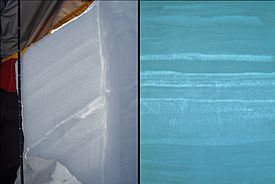Freshly fallen snow reflects more visible light than any other natural surface. In the longwave range, in contrast, it behaves like a black body. How can we use these different optical properties of snow to support our research activities?
No natural surface reflects more visible light than freshly fallen snow. In this wavelength range its albedo (reflective capacity) can be as high as 95%. On the other hand, the albedo varies according to the type and composition of the snow, and therefore differs for fresh and old snow, corn snow, and clean and contaminated glacial ice. Soot and dust significantly reduce the snow’s albedo and accelerate its melting because, when contaminated, it reflects less, and absorbs more, energy. In order to understand the albedo of snow we must first consider why snow appears white, unlike ice and therefore snow crystals as well, which are transparent in visible light (approx. 400 nm – 680 nm).
Light falling on an individual crystal refracts on its surface and changes direction. A snowflake and, on a far larger scale, the snowpack consist of a multitude of crystals. The more surfaces there are, the more often the incident ray of light bends. Once the ray of light has passed through the snow, its direction is more or less random and the reflection is diffuse; in other words, the light reflected by the snow irradiates in every direction. Each time it passes through a crystal, the light becomes a little less bright because a small portion of its energy is absorbed. Given that the snow absorbs every colour of sunlight to a similar extent, the reflected light appears white. The smaller the surface area of the snow crystals, the brighter the reflected light.
If we expose a translucent profile (a very thin wall of snow), we also see that denser snow absorbs more light. the individual snow layers in Fig. XY can easily be distinguished because their density varies.
Near infrared (NIR) ¶
In the NIR region (wavelengths of approx. 680 nm – 1200 nm, Fig. 3), ice absorbs much more light. In consequence, given the same number of refractions, larger crystals absorb more light than smaller ones. The reflective capacity of diverse types of snow therefore differs. We exploit this characteristic by photographing the snow in the NIR region in order to measure its crystals’ optical grain size (specific surface area).
Microwaves
The benefit of measurements in the microwave region (approx. 1 mm – 100 mm, Fig. 3) lies in the ability of researchers to conduct them at any time of day and with any amount of cloud cover. A single measurement can encompass an area between 20 square centimetres and 20 square kilometres (remote sensing by satellite). Microwaves are used in particular to establish how much water is stored in the snow (snow water equivalent). For this purpose, the spectrum and strength of the microwaves reflected by the snow are measured. To date, researchers have been unable to unequivocally interpret the relationship between the reflected microwave signal and the snow – a strong reflected signal could be attributable to either a large quantity of snow or large snow crystals.
For this reason, additional field measurements must be taken alongside the radiation campaign in order to characterise the snowpack. In this way we are learning about the interaction of the snowpack with microwave radiation, and how to interpret the signals received by satellites.
The diverse snow measuring techniques developed by the SLF (e.g. SMP, CT and others) allow the relevant parameters to be captured with high temporal and spatial resolution. Apart from their density, the grain size of snow crystals is an especially important variable. Our field measurements also allow the horizontal variability of the snowpack to be determined and thus facilitate research into its influence on the microwave signal.



